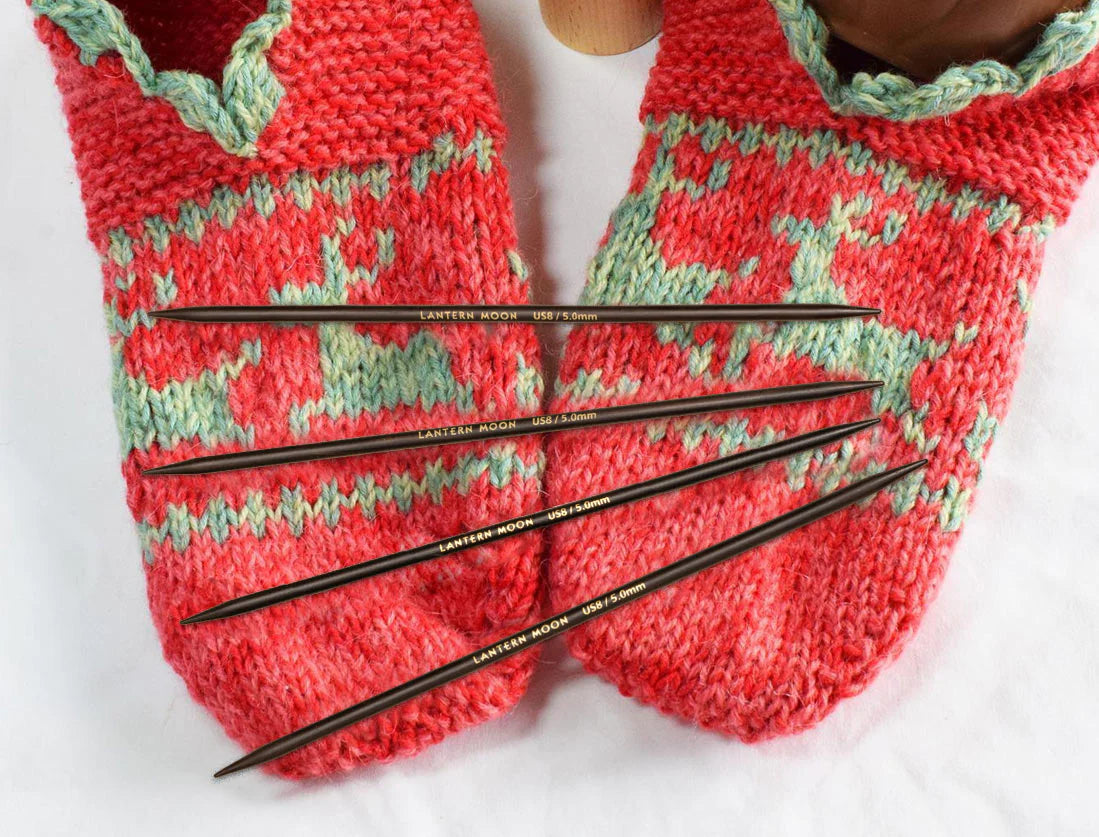
Knitting with double-pointed needles is like magic, you have a seamless tube growing on three or four needles. Knitters have been using them for centuries to knit things in the round. Earlier, we discussed how to knit with double-pointed needles, and in this blog, we’ll discuss some expert tips for working with DPNs. Whether you are knitting with DPNs for the first time or for the 1000th time, there is always the chance for mistakes. After all, you have five needles and ten pointy tips for managing. It does feel like tackling a porcupine. So, let’s avoid the errors and knit like a pro with the following tips.
1. Divide Stitches evenly, but use one needle tip to cast on stitches
Knitting with double points means working with multiple needle tips, but that does not mean you cast stitches on each needle. It is best to cast stitches on one needle tip and divide them evenly. Do not slip the last cast-on stitches; slip the last stitch on one needle while transferring the first cast-on stitches, including the slip knot on the other needle.
Say you have to cast 40 stitches. Use one needle and any cast-on method to make loops. The slip knot is often considered the first cast-on stitch. Now, if your pattern asks to use three DPNs, slip 13 stitches on one needle and 13 on the other, leaving you with 14 stitches. After dividing the stitches, join the round.
2. Invisible join by slipping a stitch
There are many ways to join the stitches when you knit in the round whether you work with DPNs or circulars. An invisible join is a knitters’ favorite. To make an invisible join, do not knit the last stitch of the round but slip the stitch on the needle tip. If you plan to join slipped stitch, cast an extra one. While you slip one stitch onto the needle, slip the stitch from another needle back on the previous one, thus making an invisible and neat join. While there are also many other methods, this trick will help avoid ladders which are a common problem when knitting with double points.
3. Avoid laddering by tightening the second stitch of the round
Ladders are stitches that are stretched or far apart where two needles join. They are the gap visible between two knitting needles and one of the most common problems knitters face when working with double-pointed knitting needles. They also look like an aftermath effect of a dropped stitch. The most recommended tip is to tighten up the second stitch to avoid ladders when knitting in the round. A tight first stitch is not advantageous as it makes working too tricky. It is better to tighten either the second stitch on every DPN or the last stitch of the round.
4. Move the stitches on the needle arrangement
Managing the multiple needles is overwhelming, which often is the cause of uneven knitting tension. To knit like a pro with DPNs, an essential trick is to move the stitches on the needles after every round. Ensure the working needle (the knitting needle you knit with) is on top and not under the needles.
5. Always knit a Gauge Swatch
A trick to knit like a pro with DPNs and other knitting needles is always knitting a gauge swatch. Make sure to craft your swatch in the round for your round project. You can find more information on the yarn and knitting tension with the swatch.

6. Add Stitch Markers the Right Way
Stitch markers assist with knitting, and when knitting in the round, the tail of the yarn used to cast on stitches will always help you identify your first needle and the start of the round. Many experienced knitters avoid using stitch markers because they are well-versed. Stitch markers on DPNs are added, not on the last or first stitch, as the marker is likely to fall off the needle tip. The trick is to add markers on the second last stitch or between two stitches so the marker can do its job perfectly and remind you of the start of the round. If it's for marking the change of pattern, it’s recommended to use a locking stitch marker. If you are a beginner, refer to our guide on using stitch markers.
7. Protect your needle tips and stitches
The most prominent fear knitters have when knitting with double points is that the stitches will fall off the needle tip. If you plan on taking your knitting outdoors, keeping them in your craft bag, or taking a break for the day, make sure to use the needle protectors. As DPNs don’t have stoppers on either end, it’s easy for stitches to fall off the needle. You can use needle protectors or end caps from your interchangeable circular knitting needle sets or grab a couple of rubber bands and tie them onto the ends of DPNs to act as an instant stopper.
8. Add Knitting Needles to your needle arrangement
When working with double pointed needles, always keep the stitches as your priority. If you are following a pattern and they ask you to use three needles, and you find it uncomfortable, use the fourth needle or add more if needed.
9. Practice and Give it Time
Knitting with DPNs can feel overwhelming for beginners. It is tough to manage multiple needles at once, but the secret is always knitting with two needles while the rest hang on the knitted fabric. With practice and time, working with these pointy needles is easy. With points on either end, they often feel like wrestling with a porcupine. But, as you explore the tricks, you can see double points work out smoothly and create a seamless tube.
10. Invest in the Right Set of Double Pointed Knitting Needles
Good-quality knits start with good-quality ingredients. So, constantly invest in the right set of double-pointed knitting needles. Knitting needles are a matter of personal preference, and there is no wrong option. Explore the needle lengths and sizes to get the right fit.
Even for knitting accessories, aka knitting essentials such as scissors, stitch markers, row counters, needle sets, etc., make sure to invest in quality. They will last a lifetime and reflect their finesse in work.
If you follow these knitting tricks, you’ll soon reach out for your double-pointed knitting needles from the Lantern Moon Collection for every seamless knitting project. The most important thing to remember is to enjoy your knitting. The premium knitting needles are crafted from ebony wood, handcrafted by skilled artisans are designed for a smooth knitting experience every time. Once you enjoy your knitting needles and yarn, you’ll express your creativity quickly and smoothly.
